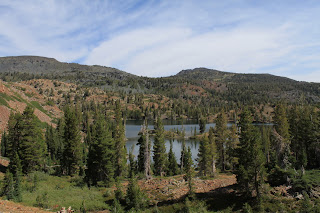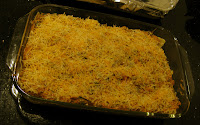Trip: Camping - Lake Tahoe Desolation Wilderness
Dates: 21st Aug & 22nd Aug 2009
Route: Glen Alpine Trail Head -> Angora Peak -> Lake Aloha -> Heather Lake -> Susie Lake -> Gilmore Lake -> Mount Tallac -> Cathedral Lake -> Fallen Leaf Lake -> Glen Alpine Trail Head
Lowest Altitude: 6300 ft
Highest Altitude: 9800 ft
Howlas: 5
Day 0 - Collect Gear and Pack
Individual Gear:
1 cap/hat, 3 t-shirts/dry-fits, 1 shorts, 1 swimming trunks, 1 track pants, 1 fleece, 1 rain jacket, 3 pair socks, 1 pair hiking boots, sunglasses, 1 head lamp, 1 eating bowl, 1 spoon, toilet paper, medicines, 1 sleeping bag, 1 sleeping pad, 1 backpack, some cash, cellphone
Group Gear (group size 5):
2 tents, 2 Matches/Lighter, Purification Pills, Sunscreen (70SPF), Ziploc bags, mosquito repellent, duct tape, compass, 2 knives, 1 detailed map, 2 bear canisters, 2 cameras, for cooking - 2 pots/stove/fuel, food - carry mostly dry precooked food, extra batteries, 2 cameras, hand sanitiser.
With the above stuff...each backpack weighed between 26-30 lbs.
Activity: 5 of us got together at 5 PM on the Enterprise at El Camino Real to checkout the rented Kia. Chilled out at the swimming pool. Went to Stanford University to rent the camping gear at around 8 PM. It came to around $35 per person. Then we decided to eat some sushi...so we went to
Sushitomi in Mountain View. It was nice. We were back by 10 pm. We packed and chatted till 12:30 AM...until we realized it was time to sleep.
Day 1: Drive to the Glen Alpine Trail Head & the 6 mile climb
Got up in the morning at around 3:30AM and were on the road by around 4:45AM on our crammed Kia. We had to reach the Rangers Station in order to get the permits for camping. The plan was to camp at Lake Aloha and there are only 36 people allowed in that area. We stopped for breakfast in between and were lucky enough to reach on time to collect the last 5 permits.
Map of the drive from Mountain View (A) to Glen Alpine Trail Head (C) through RangersStation (B)
We spent quite some time to find the Rangers Station. After getting the permits we started for the Glen Alpine Trail Head which was another hour. By the time we reached the Trail Head it was 11:30AM.
Address of the Rangers Station
United States Government Forest Service: Pacific Ranger Station
7887 Highway 50
Pollock Pines, CA 95726-9110
(530) 644-2349
We parked the battered Kia on the Glen Alpine Trail Head. Ate some bananas, took a pee on the rock, applied the sunscreen and were ready to hike. We took the tougher of the two routes available - one was a 6 mile climb through the Angora Peak and the other one was a milder trek of 4.5 miles. It turned out that Angora Peak was really very tough, especially for the first time climbers like myself. It was a unmaintained trail and was a steep climb through rocks and bushes from 6300 ft to 8400 ft. We started at 11:45 AM and with our slow pace reached the top at around 4PM. You get some quite beautiful views of Lake Tahoe, Fallen Leaf Lake and Echo Lakes from Angora Peak. We had lunch of burritos when we reached marker for Echo Peak and Lake Aloha.
The tough climb was done and it was another 2 hrs mild walk after that to reach our campsite. We reached lake Aloha at around 6:30 PM and found a nice campsite to setup our tents. We had finished the drinking water we had brought with us. We got some water from the lake and purified it. We had hot chocolate and a delicious dinner of lasagna, meat balls and chicken breasts...thanks to preserved precooked mountain food. After that we just lay on the rocks and looked at the star filled sky. I had never seen so many stars and since it was a moon less night, it made the sky all the more brilliant. That long hard climb of Angora Peak was worth it. We slept at around 11PM.
Day 2: 10 mile trek through Gilmore Lake & Mt Tallac and the drive back
Got up in the morning at around 7:30AM and had breakfast of oatmeal, bagels and salami along with black coffee. Then we decided to change into our swimming trunks and spend some time playing in the water. It was refreshing and we got some nice pictures of the lake. After breakfast, swimming and the daily routines we started to move forward with our 10 mile trek.
Our first destination was to reach Gilmore lake while passing through Heather Lake and Susie Lake. We started at 10 AM and reached Gilmore Lake at around 1:15 PM. The trail is maintained all along so it was not as tough as the first day climb of Angora Peak. Also our altitude at Aloha lake was 8200 ft and we gradually descended to 7800 ft until Susie lake and then we moved up to 8400 ft at Gilmore Lake. We had a light lunch at Gilmore lake and decided to climb Mt. Tallac.
Base camp of Mt. Tallac was at 9400 ft while the peak is at 9700 ft. We decided to climb with our 28 lbs backpacks and then leave the backpacks at the base camp and climb to the peak of Mt. Tallac without them. It took us another 1 hour 15 mins to reach the base camp. The view from the peak of Mt Tallac was breathtaking. Lake Fallen Leaf looked like a small pond in front of Lake Tahoe. Mt Tallac is probably the tallest peak in that region and the panoramic view from its top is really beautiful. We spent some time taking pictures on the top and then started our descent.
The descent was tougher than expected. The terrain like everywhere else on the desolation was sometimes rocky, sometimes dusty and sometimes bushy. We had to descend around 3000 ft. We completed it in another 3 hours including a half an hour break at the cathedral lake. We were back to the Glen Alpine Trail Head by around 7 PM.
We were tired. We packed everything on the Kia and headed to an arbit Mexican bar...where I tried Mike's Hard Lemonade...which I hated. But the grilled chicken quesadilla felt good and we realized we had completed a nice trek.
Credits
The leader of our group was Abhay Sukumaran, who planned and managed the entire trek. The participants were - Nishant Joshi, Sumit Rangi, Tushar Shah and Sumit Saluja. The inspiration, i guess was for 5 friends to meet up after a long time. We may have been better off getting drunk at home....but none the less we realized that none of us has changed a single bit in 5 years. I also realized that you have to get your ass kicked to realize anything. Will do it again :)















































 Now this one requires time and a little bit of expertise to make it, but once prepared you would realize that it is worth the effort. It is one of the best Italian dishes I have eaten, well probably because I ate the home cooked version. For people who don't know what Lasagna is - its another type of pasta. It comes in long flat strips, 3-4 cms wide and 12-15 cms long. Its prepared by making alternate layers of lasagna stripes, meat sauce and cheese one over the other. You prepare the sauce separately, boil lasagna and then make alternate layers. The outcome is layers of creamy, spicy, tangy and very tasty food. Well lets look at the recipe - its quite simple if you break it down into steps.
Now this one requires time and a little bit of expertise to make it, but once prepared you would realize that it is worth the effort. It is one of the best Italian dishes I have eaten, well probably because I ate the home cooked version. For people who don't know what Lasagna is - its another type of pasta. It comes in long flat strips, 3-4 cms wide and 12-15 cms long. Its prepared by making alternate layers of lasagna stripes, meat sauce and cheese one over the other. You prepare the sauce separately, boil lasagna and then make alternate layers. The outcome is layers of creamy, spicy, tangy and very tasty food. Well lets look at the recipe - its quite simple if you break it down into steps.
 Mix everything well and then leave it on medium heat until the spinach get cooked. When the spinach is cooked and the sauce is slightly thicker then turn off the heat and add Sour Cream to it. Mix it well and then taste the sauce - add extra salt, red chilly powder or Sour Cream as per your taste. All right your sauce is done now keep it aside. It is a creamy, spicy and tangy, i am sure you would love it. You can have your own version of sauce - just experiment carefully :)
Mix everything well and then leave it on medium heat until the spinach get cooked. When the spinach is cooked and the sauce is slightly thicker then turn off the heat and add Sour Cream to it. Mix it well and then taste the sauce - add extra salt, red chilly powder or Sour Cream as per your taste. All right your sauce is done now keep it aside. It is a creamy, spicy and tangy, i am sure you would love it. You can have your own version of sauce - just experiment carefully :)